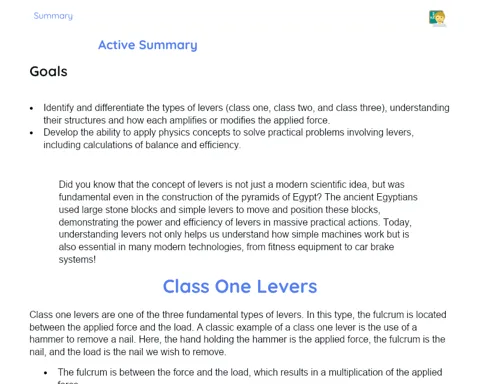Exploring the World of Angular Displacement: From Theory to Practice
Objectives
1. Differentiate angular displacement from linear displacement.
2. Calculate angular displacements in practical situations, such as the variation in the position of a clock's hand.
3. Apply the concepts of angular displacement in job market contexts, such as the analysis of the movement of rotating machines.
Contextualization
Angular displacement is a fundamental concept in physics, especially when dealing with circular motions. Imagine a cyclist going around a circular track or the hand of a clock moving throughout the day. These are clear examples of angular displacement in action, where the position of an object changes along an arc of a circle. Understanding this concept is not only essential for solving academic problems, but also has various applications in the real world, from mechanical engineering to robotics.
Relevance of the Theme
Angular displacement is crucial for the operation of many industrial machines and technological systems. In an automobile factory, for example, the movement of many parts is based on specific rotations and angles. In robotics, the angles of rotation determine the precision of robot movements. Additionally, in navigation, angular displacement helps calculate the change in direction of ships and aircraft. Understanding this concept is essential for careers in engineering, technology, and many other fields.
Angular Displacement
Angular displacement refers to the change in position of a point along an arc of a circle, measured in radians or degrees. It is a measure of how much a point or object has rotated around a fixed axis.
-
Defined as the change in angle along an arc of a circle.
-
Measured in units such as radians or degrees.
-
Essential for describing circular movements.
-
Used in various fields such as mechanical engineering and robotics.
Linear Displacement
Linear displacement is the change in position of an object along a straight line. It is a scalar measure that considers only the magnitude of the change in position, without taking into account the direction.
-
Measured in units of length such as meters or centimeters.
-
Describes straight line movements.
-
Important for the analysis of rectilinear movements.
-
Different from angular displacement, it does not consider rotations.
Calculating Angular Displacement
To calculate angular displacement, it is necessary to know the initial angle and the final angle of an object in circular motion. The difference between these angles provides the angular displacement, which can be expressed in radians or degrees.
-
Angular Displacement = Final Angle - Initial Angle.
-
Can be measured in degrees or radians.
-
Important for determining the total rotation of an object.
-
Used in various physics and engineering problems.
Practical Applications
- In an automobile factory, angular displacement is used to calculate the rotation of parts and ensure the precision of machine movements.
- In robotics, angular displacement determines the precision of robot movements, essential for tasks that require high precision.
- In navigation, angular displacement is used to calculate changes in direction of ships and aircraft, ensuring accuracy in route determinations.
Key Terms
-
Angular Displacement: The change in position of a point along an arc of a circle, measured in radians or degrees.
-
Linear Displacement: The change in position of an object along a straight line, measured in units of length.
-
Radians: An angular measurement unit used in the calculation of angular displacements.
Questions
-
How can the concept of angular displacement be applied in the development of new technologies and machines?
-
In what ways is angular displacement relevant to the precision of movements in robotics and automation?
-
What is the importance of angular displacement in navigation and how does it contribute to the safety and efficiency of air and sea travel?
Conclusion
To Reflect
The study of angular displacement allows us to better understand how rotations influence various machines and systems in our daily lives. From the precision of movements in robotics to the safe navigation of aircraft and ships, angular displacement is a key component in many modern technologies. By mastering this concept, we open doors for careers in engineering, technology, and other areas that require a deep understanding of circular movements.
Mini Challenge - Angular Displacement Simulator
Let's create a simple simulator to visualize and calculate angular displacement in practice.
- In groups of 4 to 5 people, gather materials: cardboard, ruler, protractor, clock hands (or similar) and glue.
- Draw a circle on the cardboard using the protractor and ruler, marking angles of 0°, 90°, 180°, and 270°.
- Fix the clock hand at the center of the circle so that it can rotate freely.
- Move the hand from one position to another, noting the angular variation in each movement.
- Present your observations to the group and explain how you calculated the angular displacements.



